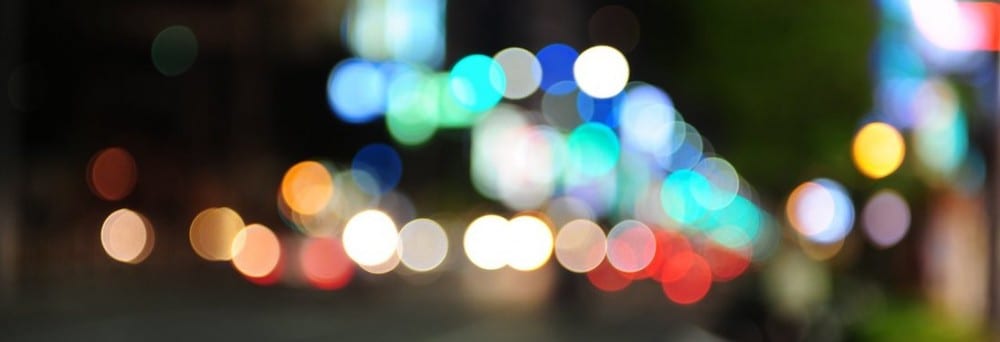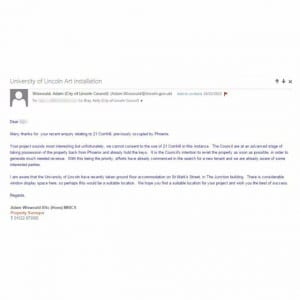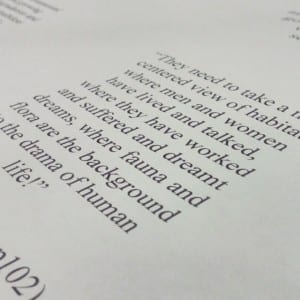Framing Statement
Our process was guided by the criteria of the Frequency Festival; they wanted performances to contain certain
elements, primarily pervasive media. This meant that as a group we needed to determine which form of pervasive
media interested us and design our performance around that. After much debating and deliberation we decided to
create a piece around the idea of a QR code. Our site being the high street we thought this was a good link, as QR
codes are used in retail and advertisement. This link allowed us to come up with a name and an overall concept for
our performance. Another element that the Frequency Festival wanted to be included was the theme of Liberation.
With these criteria in mind, our main aim was to disrupt the flow of the high street; to liberate people from the isolation
they create for themselves in this world of technology. We wanted to make the point that technology has made people
unable to communicate; they walk through the high street without interacting with other human beings.
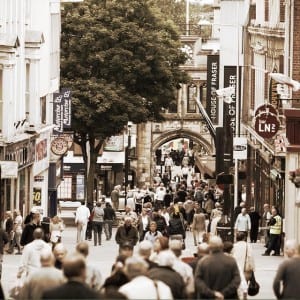
This is our site, Lincoln High Street. With its huge crowds of people passing each other by, oblivious to the world.
The QR codes themselves added another level to our performance because they are used in retail as adverts or
promotional offers that people scan. We took this idea and contorted an established vehicle; we handed out QR codes
on the high street to the people who were our audience, each of us had created 250 QR codes each to hand out. We
planned to do this from nine o clock am until five o clock pm to symbolise a traditional retail day. Our QR codes,
however, were not adverts but links to images and websites that were hopefully thought-provoking, but not advertising anything.
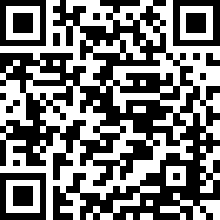
This is an example of what a QR code looks like. Notice how very digital is seems. If you scan this one it will take you to a website about environmental problems.
We each took a different sub topic to make our QR codes: Economical, Historical, Social, Process and I had
Environmental. We wanted people to question the function of a QR code; this led to our performance name,
Questioning Retail. Additionally we had T-Shirts made with QR codes that led to an image, that would further our
intention of questioning preconceived notions; our ideas developed to not just questioning retail and technology, but
to trying to make people question the things in life they take for granted. This again makes a link to the theme of
liberation; we are liberating people from their own assumptions. In particular, because we performed on May 7th,
Election Day, we tried to include political aspects into our piece. The images on our T-Shirts used the template of the
popular Keep Calm and Carry On image. Each of us had a different modification of this, for an example mine was
“Keep Your Head Down and Let Others Choose?” As a whole we were guided to this final product by practitioners like
Pearson and Debord, while also being inspired by other performances like I Wish I Was Lonely and Sit With Me A
Moment And Remember.
Analysis of Process
The first thing we did was look at Site Specific as a whole. We needed to establish what site specific means and
how we could use this as a platform on which to create our ideas. Mike Pearson attempts to comprehensively explain
what site specific performances really entail; giving examples of previous performances and using hypothetical scenarios in
particular sites. One of the most fundamental definitions is, “In which the scene is set, a personal history of practise is
sketched and a particular context of performance making is delineated.”(Pearson, M. 2010, p1). Meaning that every
individual place has its own history, its own context so a performance in a specific site can only have meaning to that
place.
From the outset we wanted to focus on how modern technology has effected society; how people communicate more
frequently through social networks than actually talking. This focus allowed us to develop ideas that relied heavily on
pervasive media and audience interaction. Our first idea for a performance was inspired by a workshop we attended
about an innovative technology called ‘The MakeyMakey’. This new creation focused on the ways in which humans
and technology could interact, how just the simple action of having skin contact with a device made it work. The idea
we came up with was to have points of contact around our body that when touched would reveal an image, video or
an audio tour. We wanted to establish a link between human contact and technology, to reconcile the biological and
the artificial. After trying to develop this idea we realised the impracticalities; the amount of wires and safety concerns
were too high. Also the number of different images, videos, etc would have required a huge amount of complex
technology that none of us had experience in. However, this led to the idea of being critical about technology, to make
the audience question what has become a fundamental aspect of life. This idea was further reinforced after we
attended the performance I Wish I Was Lonely by Hannah Jane Walker and Chris Thorpe. This performance was
focused on mobile phones and how they have effected the modern age. The way the performers handled the audience
interaction was, in my opinion truly inspired; they found the perfect balance of familiarity and distance, performance
and conversation, seriousness and comedy. They had the courage to completely engage with the audience, allowed
trust to develop. This is something we wanted to replicate in our performance; a relationship with the audience based
on mutual trust.
We started to research previous performances and practitioners to develop our performance. One performance that
we all found to be a useful inspiration was Michael Pinchbeck’s Sit With Me For A Moment And Remember. This
performance was “A bench with a plaque reading Sit with me for a moment and remember is placed in a public space.
It is both a dedication to a loved one and an invitation to a stranger. You are invited to sit on the bench to listen to a
recording that reflects on what it means to sit for a moment and remember.”(Pinchbeck,M 2015).

This is an image depicting an example of an audience member participating in this performance. As shown the audience are left vulnerable, ears covered, eyes closed; they put their trust in a complete stranger.
https://blackboard.lincoln.ac.uk/bbcswebdav/pid-950065-dt-content-rid-1850472_2/xid1850472_2
Like with I Wish I Was Lonely, Pinchbeck invites a relationship with his audience, asks them to be vulnerable; to sit on
a bench alone and even close their eyes. We definitely wanted to replicate some form of audience interaction in our
performance. We looked into other performances that had a high level of audience participation; Janne Tapper
reviewed a performance by an innovative theatre group know as ‘The Yes Men’ in her article Pervasive Games. These
performers took a completely different approach to audience interaction rather establishing trust, they shattered it, “in
that brief moment when the audience discovers that a speaker and his speech, which they considered real, are not
real but are playing. And the audience’s sense of insecurity, uncertainty and even danger rise in that moment.”
(Tapper, J 2014). Pervasive Games gave me a new perspective of pervasive media to consider. If we created a piece
using pervasive media, we would be forcing an audience to confront a truth about their own lives that they were either
unaware of, or did not want to acknowledge. The unaware audiences that were the victims of a pervasive game
became afraid, insecure and paranoid when confronted with the truth. Though we agreed that ‘The Yes Men’ created
a revolutionary new form of performing, we thought the extremity of their method creates fear and mistrust in an
audience, they were even compared to terrorists, “they use fake identities and tell lies, just as terrorists do.”(Tapper, J
2014). We wanted to incorporate the element of confrontation, but were more inclined to create a relationship of trust
rather than fear with our audiences.
With this research we started to create some new ideas for our performance that centred around confronting and
questioning the world with a particular focus on the new age technologies; whilst keeping audience involvement and
reaction a primary concern. As we rejected our last idea due to its complexity, we went back to basics. We needed to
make our performance link to our site as, “a place owes its character to the experiences it affords to those who spend
time there-to the sights, sounds and indeed the smells that constitute its specific ambience. And these, in turn, depend on the
kinds of activities in which its inhabitants engage.”(Pearson, M. 2010, p15). We looked at our site, the high street and
what it made us think of such as: cattle, consumerism, retail, advertisement, shopping, etc. This led to the idea of
disruption; we all agreed that one of the most obvious things in the high street is the mass of people who are shopping
or looking at phones. We wanted our performance to disrupt this autonomous movement through the streets, to make
people interact with others. Our main concern became how we get the people, our audience to stop and talk to us; to
break away from their consumer-driven, technology-controlled lives. A performance called Binary Graffiti involved performers creating artwork on the walls and
pavements, using binary code whilst wearing outfits that had binary code printed on them.
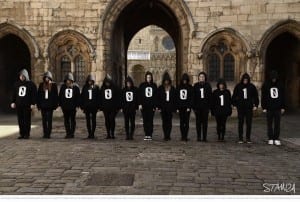
This image shows that these performers use the idea of the digital era as a basis for their performance. The uniformity of their outfits makes them stand out. We were inspired by this in our piece.
“The Binary Graffiti Club provides a platform to celebrate the pioneering spirit of digital innovation and culture through
creative collision and socially engaged artistic practice. The Binary Graffiti Club inspires young people to see the city
as canvas to create change.” (The Binary Graffiti Club, website.) This performance group inspired us to create clothing
that would make us stand out in the crowd, to make it clear that we are members of a group that is set apart from the
rest. We also liked the simplicity of not actually including technology, but using the concept of the digital age as a basis
for a piece. This is when we came up with the idea of QR codes, we thought about the digital age in relation to the
high street and QR codes were the most obvious choice. QR codes dominate consumerism, companies use them for
advertisement or promotional codes. A QR code needs to be scanned by certain applications that can be downloaded
onto a smart phone. When scanned they will take you to a website or an image that would traditionally be advertising
something. We wanted to create T-Shirts that would have a QR code printed onto them; this would make us stand out
in the crowd and hopefully invite conversation.
We wanted to incorporate the aspect of making the audience question the established norms of their lives; in this case
their assumption would be that we were advertising something, so we wanted to challenge that by creating QR codes
that had nothing to do with retail or adverts. This is how we came up with the title of our piece, QR would ordinarily
stand for Quick Response, but as we are challenging this concept we changed it to Questioning Retail, as that is
exactly what we wanted our audience to do. This concept of making an audience question themselves, particularly in
the high street was inspired by a performance by Claire Blundell Jones, Tumbleweed. “The two, woman and weed,
suggest a wilderness within and about us; densely populated suburbias are touched by the cinematic signifier of
emptiness, loneliness and distance.”(Jones, C. 2010). She wanted to escape the Western world and walk with no
purpose or destination, this was something we wanted to make our audience think about.
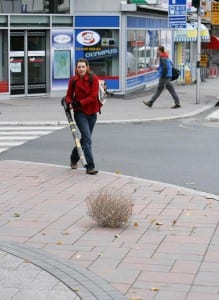
This shows Claire Blundell Jones walking the busy streets blowing a tumbleweed in front of her. The juxtaposition of this and the constantly in flux high street created a beautiful aesthetic that we hoped to recreate in some fashion.
This was a good starting point, but we felt that we needed something more to get the audience involved. We
developed the idea of producing hundreds of QR codes and creating an installation along the high street. The
performance would be all of us creating a work of art made entirely of QR codes that people could scan at their leisure.
We felt this would create more of a visual impact and attract more people to interact and cause them to look up and
take notice. This idea of a visual impact with an aim of making you question the world is something that we derived
from the works of practitioner, Guy Debord. He is a situationist and believes in questioning the capitalism of society,
he thought that “the spectacle is capitol accumulated to the point that it becomes images.”(Debord, G. 1992, p17). An
art installation links to his concept of the spectacle, something that visually questions capitalism in its current
consumerist form.
The main concerns of our piece became the content of the QR codes and getting permission to create an installation
in the high street. In regards to to the content, to avoid repeating ourselves we each took one of five topics:
Economics, Historical, Social, Environmental and Process. We would create QR codes that linked to our chosen topic.
For example I would create a QR code that would link to a website about animal testing; this makes the person who
scanned the code question the assumed purpose of QR codes, and an aspect of the retail industry that we would
ordinarily choose to ignore. To make our QR codes we used the site below:
The content of the T-Shirt codes was another issue, we wanted people to come and talk to us whilst building the
installation; thus full-filling the aim of human interaction. Originally we thought about having something personal or unique on the T-Shirts.
Personally I was inspired by Tim Etchells’ Eight Stages, there is a particular passage that influenced me where he
creates his own folk tales, “People say here that this man is keeping the city alive.”(Etchells, T. 1999, p77). I wanted to
create my own folk tale about Lincoln and use it for my T-Shirt QR code. This, however wasn’t really in-keeping with the concept of questioning retail so this idea was discarded. The group wanted our T-Shirts to be
relatively the same whilst being simple and evocative. I suggested we use the popular image of “Keep Calm and Carry
On” and change the writing to make it question the world we live in.

This is an example of the images that the QR codes on our T-Shirts led to. This one was mine linking to politics, how few people vote; how they let others decide what society they live in. The question mark was something all the images shared, to further the aim of making people question the things they take for granted. We called this Passive Criticism.
With the content of the QR codes decided we focused on the practicalities of the performance. I called the council to
attempt to secure a building for our installation. While waiting for a response, we realised there were many factors
that would be a hindrance to us. We would need to have laptops and printers on the day to create the QR codes and
print them off; we would need somewhere to plug these in and the potential for rain gave us some trepidation. We
would also need access to the internet which was proving a difficult challenge to overcome. However we had to
amend our idea regardless because Lincoln Council did not give permission for the use of our chosen building.
We decided to create and print all our QR codes, 250 each beforehand and hand them out as leaflets on the street.
This is in-keeping with our main themes as the audience would assume we are advertising for a company or charity; we
challenge that assumption by explaining our real purpose. This change was also still using Debord’s ideas of ‘The
Spectacle’, we became the visual tool; in our T-Shirts we were going to become that ‘Spectacle’. The final parts of our
process were to create texts that would accompany the QR codes, to make people more inclined to read them and not
throw them away. Another was to create a 50 word paragraph (which can be found on our Blog) that we could all learn
that explained what we were doing, the aim being to get them to interact with us and hopefully scan our T-Shirts and
their individual QR Code. The only thing left to do was to preform our piece: Questioning Retail.
Evaluation
On the day of our performance, we spread out down the high street with our T-Shirts on and 250 QR Codes ready to
hand out. Whilst creating our QR codes we also uploaded them to our personal blog, so if people wanted to see all the
codes we made they could. On this blog is also a link to a Twitter feed that recorded the reactions we received from
the audience.
http://questioningretail.blogs.lincoln.ac.uk/
Overall I feel that the performance was a success; that we achieved what we set out to do. I spent the day offering
people my QR codes and was pleasantly surprised by how many people stopped to speak to me. One of the most
memorable instances for me was when a young man stopped the conversation he was having on his phone to ask
me what I was doing. This to me summed up all our main aims, to make someone break from their technology and
actually have a conversation with a stranger, another human being. Even the people who just took the paper and
walked away or even the ones who declined, were forced to look up and talk to me.

This was on the day of our performance. Attempting to hand out QR codes to the audience. In this picture you can see the man has head phones on and we force him to look up and interact with us.
Handing out leaflets made me view the high street in a new way; because I was trying to get people to approach me,
it only served to make how unapproachable people made themselves even more obvious. There were certain aspects
that did not work as well, like the limited amount people who actually have a QR scanner on their phones. This meant
that few people were able to scan our T-Shirts even if they wanted to, which was the case with elderly people who I
found to be the most interactive. Also not many people were interested in talking to us further, they just took the code
and walked by.
A few examples of our interaction from our Twitter page: https://twitter.com/QrRetail/status/596274607285542915
“We just got asked if we were Jehovah’s witnesses…”
“To the lovely guy who kindly gave us a free umbrella. You proved that social exchange in the high street is possible!”
“Some teenagers downloaded QR code readers just to scan our tshirts.”
If we had to do the performance over again there are certain changes I would make. The first of which would be to
have a QR scanner with each performer so that we could scan the codes for them. This would lead to more
conversation with the audience. Another element I would change would be to have us more spread out, I think we
were nervous about talking to strangers so we stayed close to each other, if we spread out more we could have had
more of a variety of audience responses. Another change I would make is to have a table set up with larger leaflets,
even posters that would draw more people in. Furthermore I would have liked to make the pieces of paper we handed
out look more professional, to print them on card and laminate them. I think this would make people more likely to take
them as they would look less like leaflets and we, as a group would come across more professional. Overall I think our
final performance went very well, we disrupted the flow of the high street and made people look up from their self-made isolation through the medium of QR codes. We as a group created a performance that liberated people from
their assumptions and attempted to make our audience think about the parts of life they take for granted.
Bibliography
Debord, G (1992). Society of the Spectacle. London: Rebel Press. p17.
Etchells, T (1999). Eight Fragments On Theatre And The City. London: Routledge. p76-81.
Jones, Claire Blundell(2010) ‘Walking, the Western and the tumbleweed’, Visual Studies, 25: 1, 87 — 88
Pearson, M (2010). Site-Specific Performance. London: Palgrave Macmillan. p1-207.
Pinchbeck, M. (2015). Sit With Me For A Moment And Remember. Available: http://michaelpinchbeck.co.uk/sit-with-me-for-a-moment/. Last accessed 14th May 2015.
Tapper, J. (2014). Representations of Existential In-Between-ness. Pervasive Games. 1 (1), 1-19.
The Binary Graffiti Club. (2013). An Art Project by Stanza. Available: http://www.stanza.co.uk/binary_club/. Last
accessed 14th May 2015.
Walker, H. Thorpe, C. (2015) I Wish I Was Lonely.[performance]Hannah Jane Walker, Chris Thorpe (dir) Lincoln: Lincoln Performing Arts Centre, 11 February.
